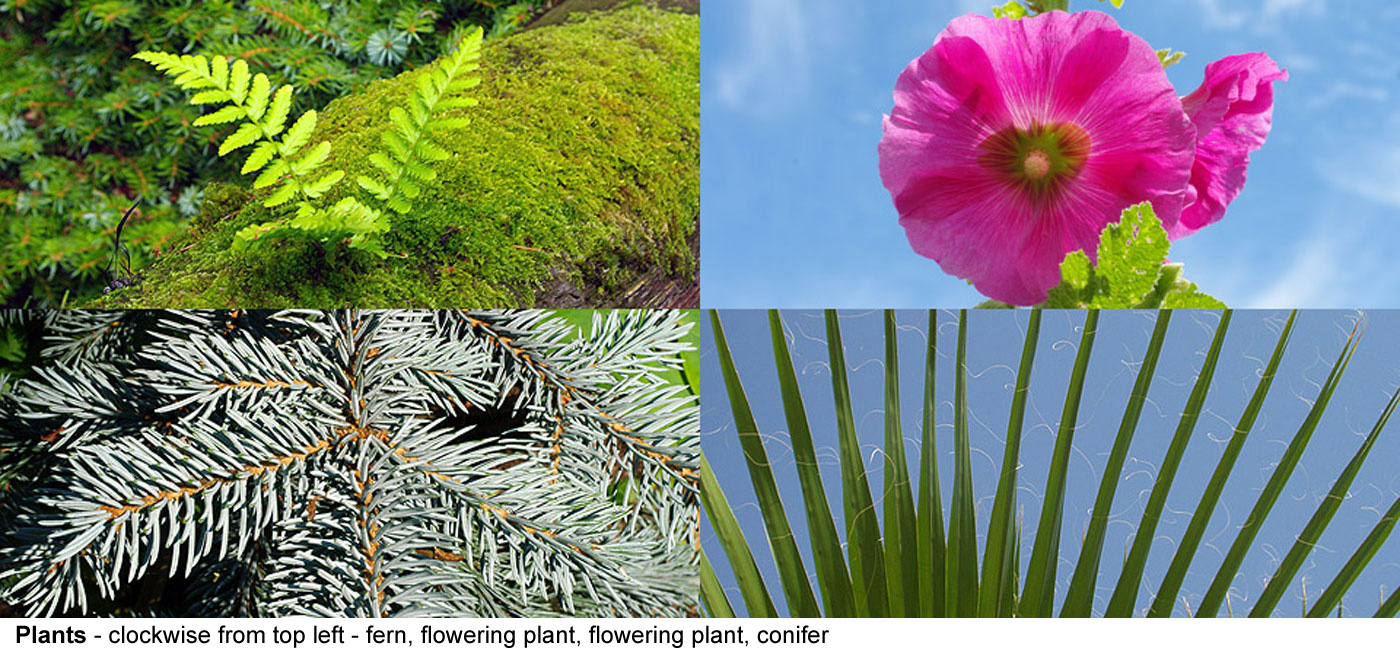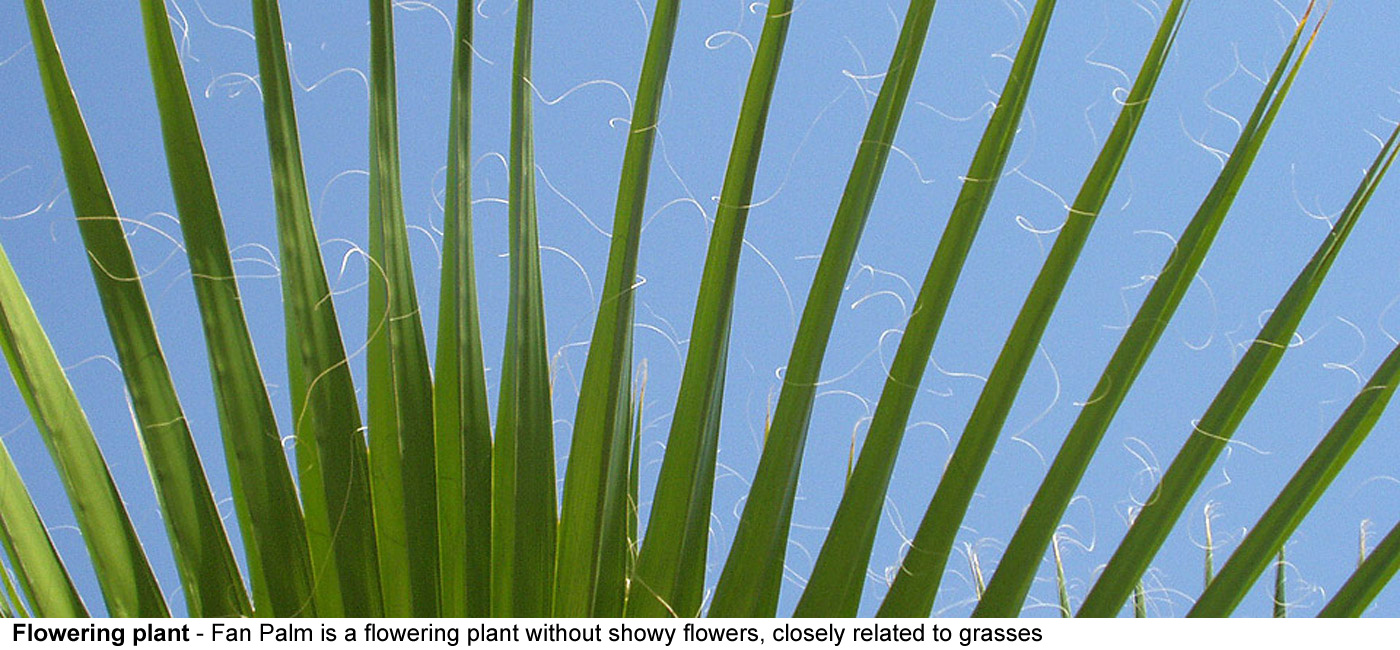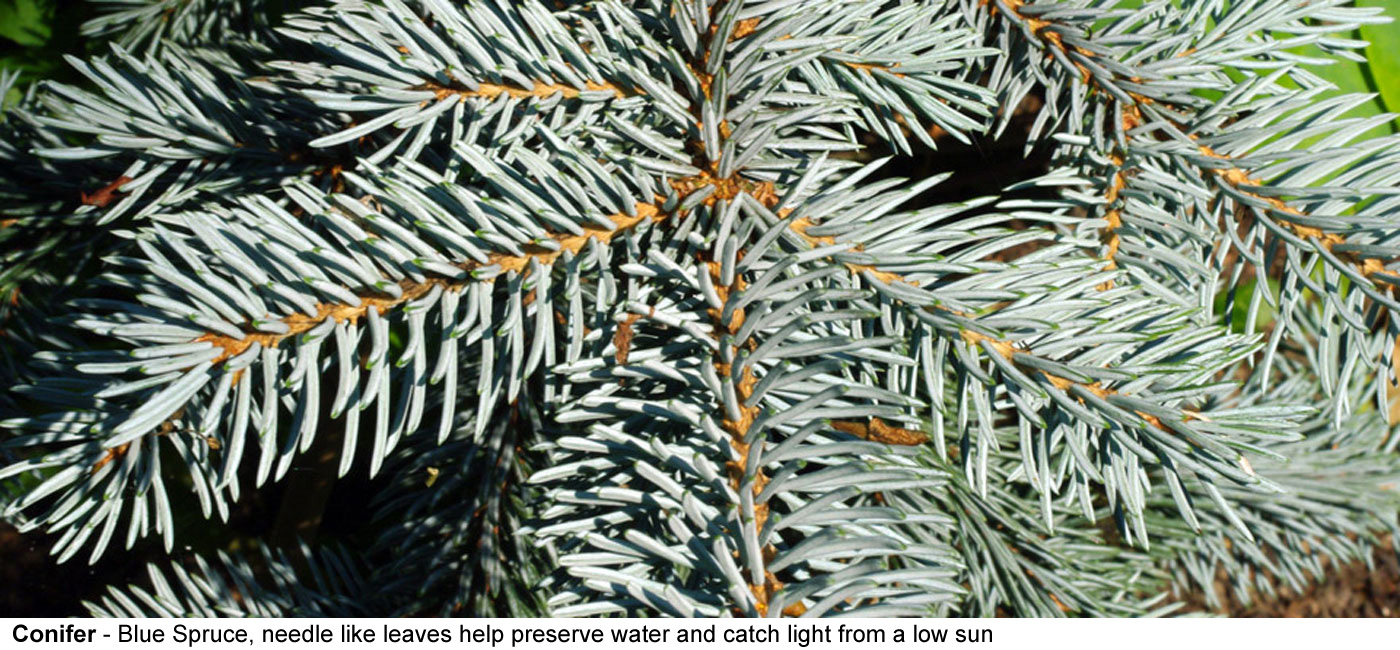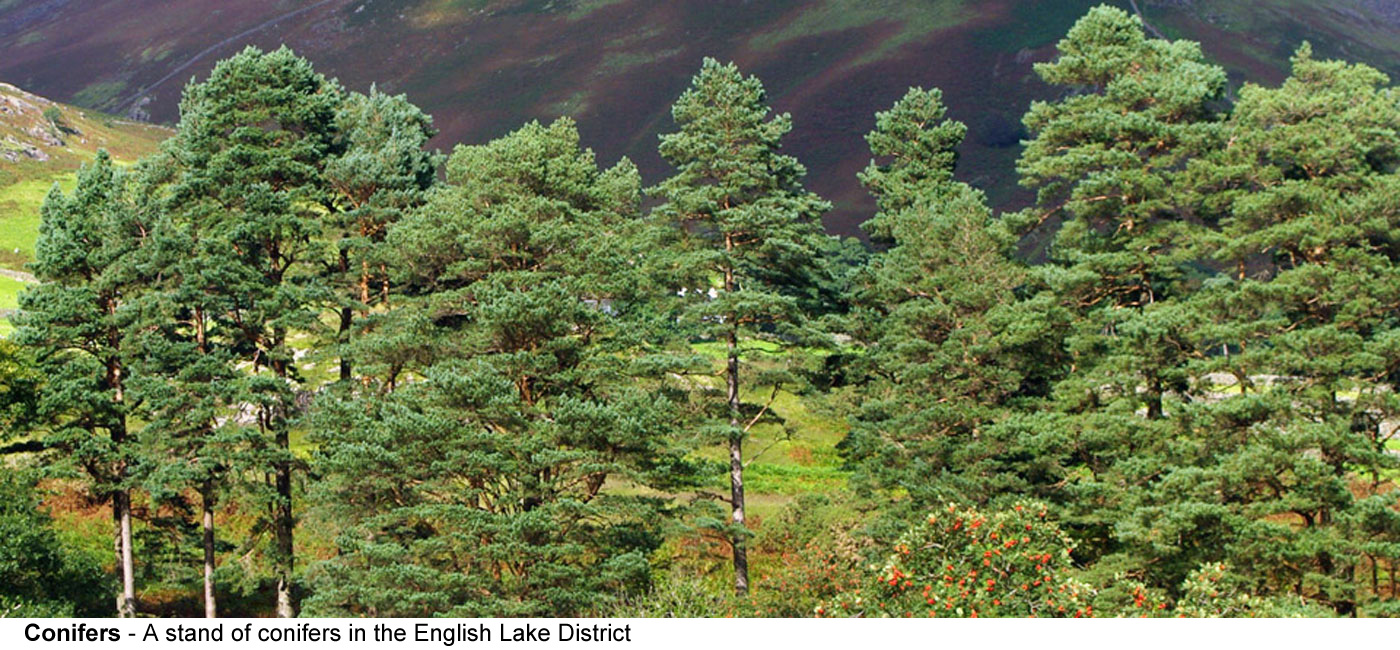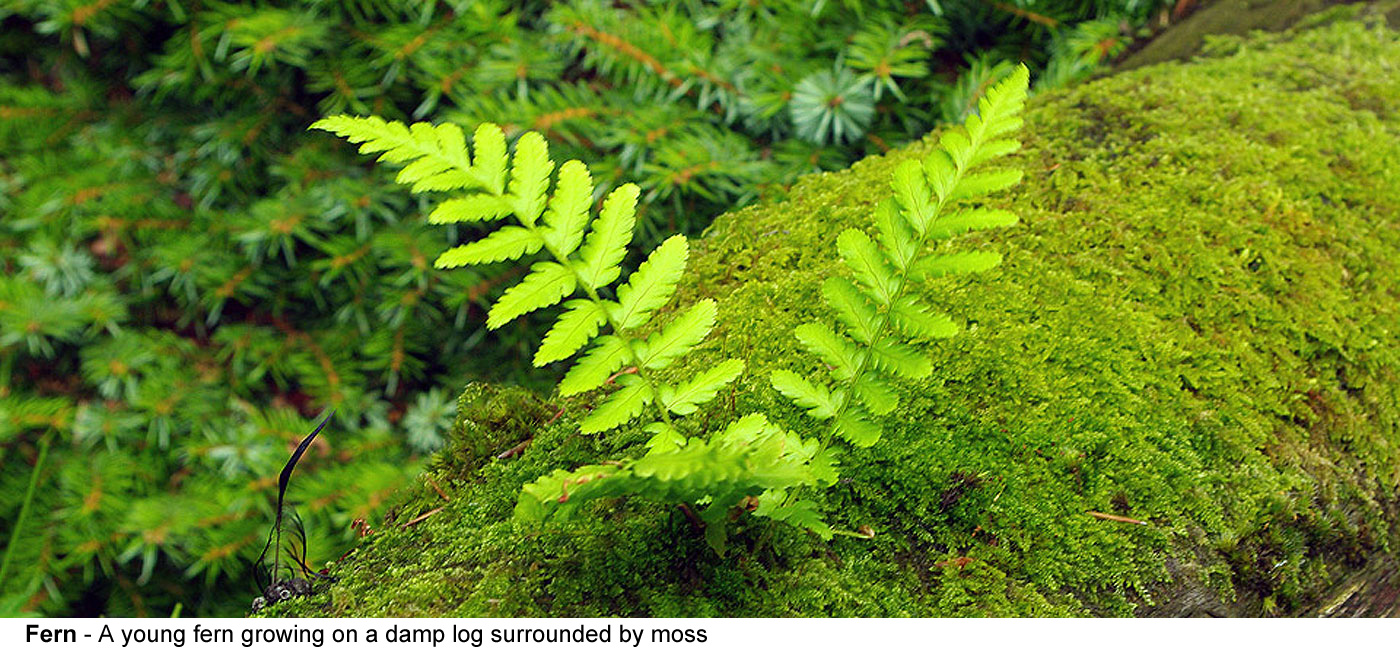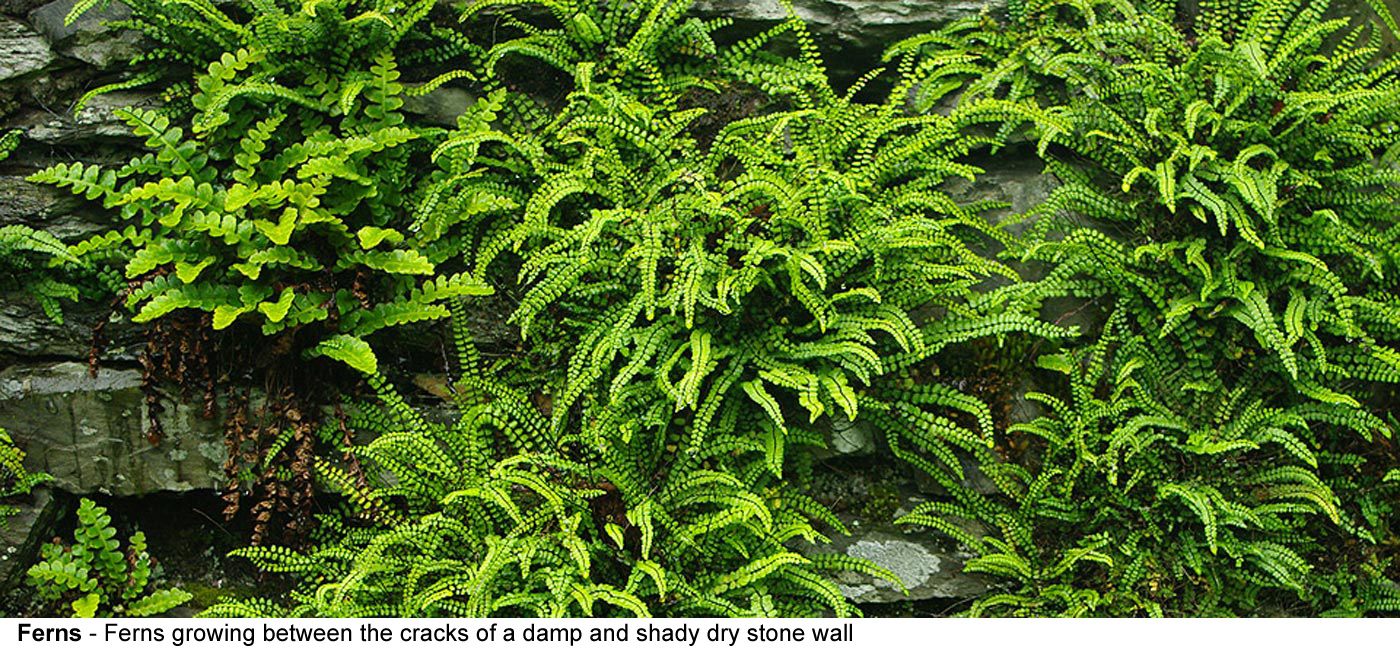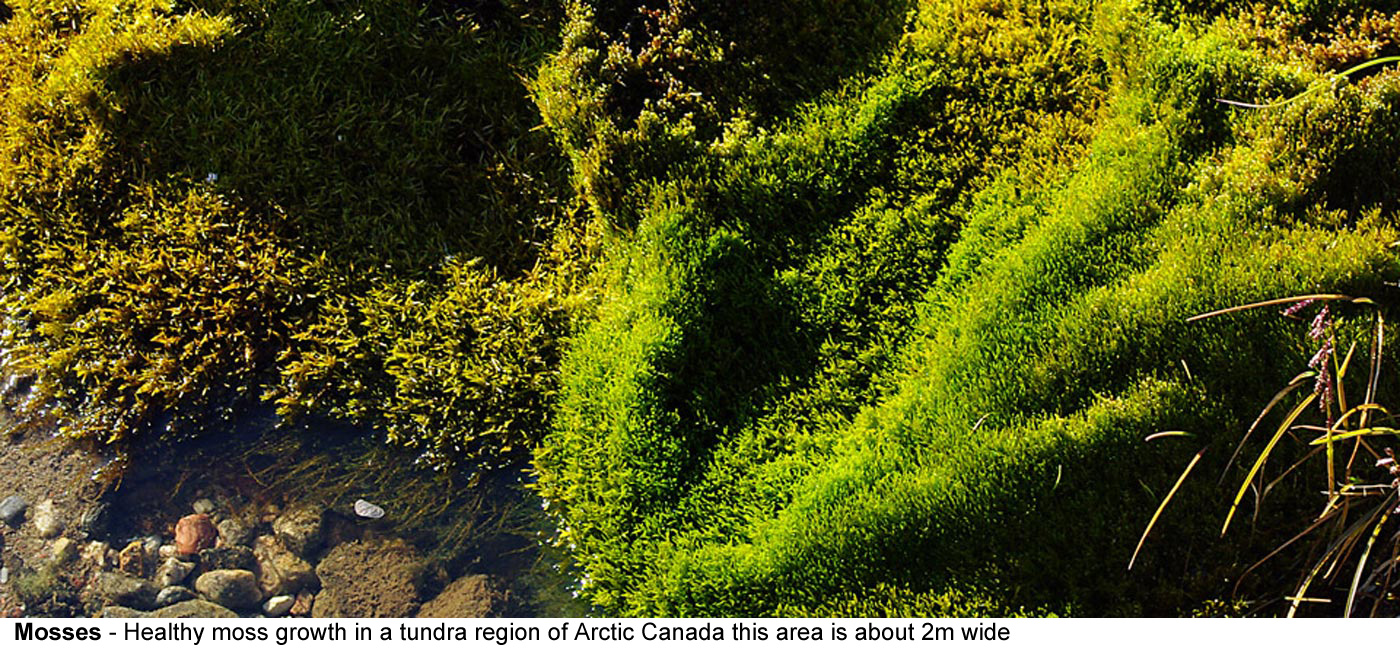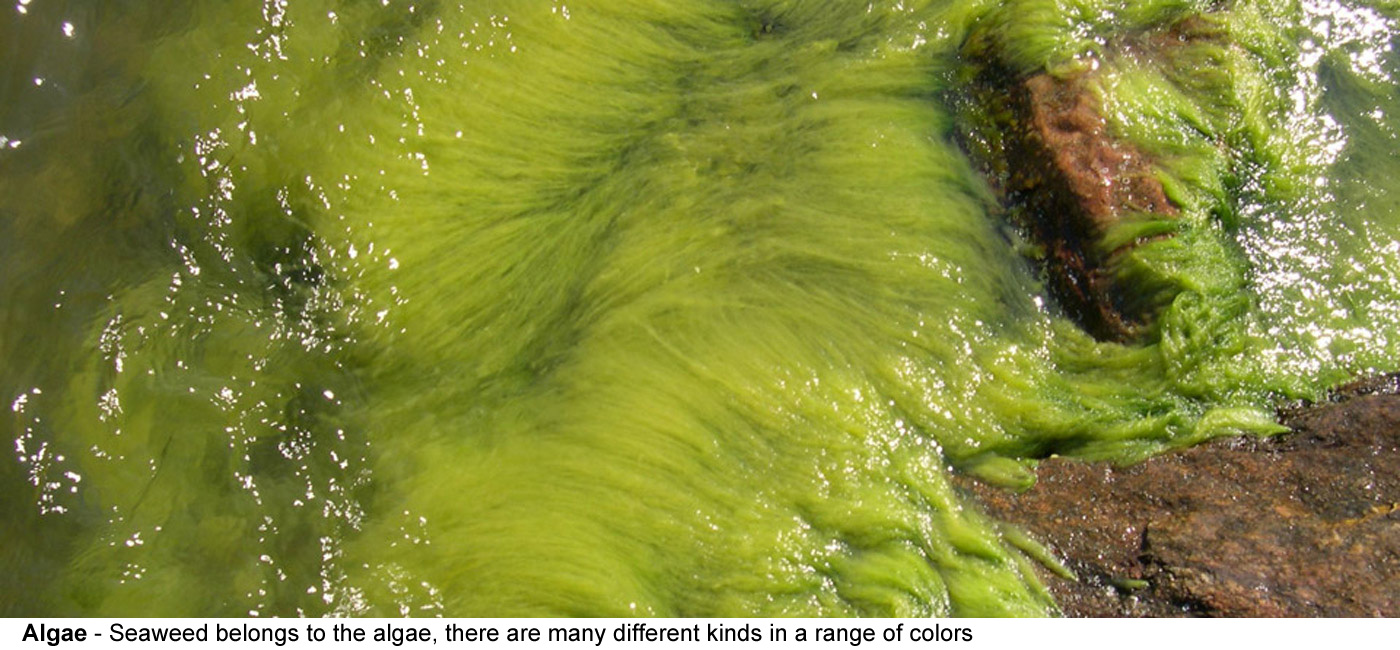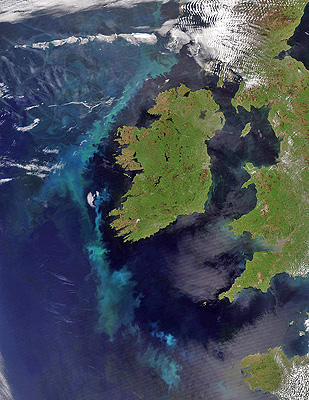 A bloom of phytoplankton to the
A bloom of phytoplankton to theWest of Ireland in June 2006
Plant Groups
Classifying plants according to evolutionary
connections
Plants are more difficult to put into groups for many people possibly as they are so completely unlike us. Even a fly has a head, eyes and legs that we can identify with to some degree, but where do you start with a plant?
Add to this that the great majority of plants that we encounter belong to the same group and that the others are relatively uncommon with the differences being not so obvious unless you start looking much more carefully and it's easy to see why most people's idea of plant groups are flowers/not-flowers or even edible/non-edible.
Botanists (plant biologists) seem to like changing their minds about what groups plants belong to even more than zoologists (animal biologists) do about animals. The following is somewhat simplified though a reasonably up to date and accurate description of the major plant groups. I have tried to arrange it for clarity, when the group names change it's not just a name change for the sake of it, though it may seem like that. Also, some plants move into and out of existing groups to confuse matters. We don't need to consider those things for this brief overview, though you may encounter the results of all this renaming and moving around when you look at various reference sources. The flowering plants group that used to be the Angiosperms for instance are now the Magnoliophyta.
Most importantly for the categorization of plants is that oxygenic photosynthesis (photosynthesis that produces oxygen) only evolved once in the history of this planet meaning that all plants have a common ancestor and very similar if not identical details of how they photosynthesize no matter how different they may appear or how they go about their lives.
Vascular plants - these are plants that have transport tissues that carry water, dissolved minerals and the products of photosynthesis around the plant.
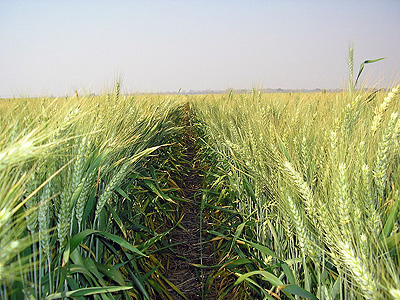 Wheat - a monocotyledonous flowering plant
Wheat - a monocotyledonous flowering plant
Angiosperms (now Magnoliophyta) Flowering Plants
- Vascular plants with large stems and roots.
- Reproduction by the production of flowers.
- Seeds formed within a fruit.
Easily the best known group of plants, the great majority of plants that you can name or eat or use in any way are flowering plants. They are defined by having flowers, seeds that have a food source called the endosperm and are surrounded by a fruit. The fruit may be fleshy and juicy as the word "fruit" implies or be a pod as in beans and peas or dry and hard like an acorn or peanut (groundnut) shell. The flowering plants are the most recently evolved major group of plants.
Flowering plants can be subdivided into two groups, the monocotyledons and dicotyledons. The name refers to the cotyledons or "seed leaves" these are the first leaves that emerge from the germinating seed, monocotyledons (monocots) produce one seed leaf and dicotyledons (dicots) produce two (you saw that coming didn't you?). This sounds like a small difference but has more significant consequences when the plants grow. Dicots are sometimes called "broad leaved" plants for reasons that are obvious if you look at a leaf from such a plant. The veins of dicots diverge from a large central vein, monocots by comparison have veins that are parallel, the leaves of these are often long and thin.
Angiosperm examples:
Monocotyledons: All kinds of grasses including crops such as wheat, rice, maize, oats, barley and other cereals. Also, bamboos, sugar cane, all kinds of palms, onions and the onion family such as leeks and garlic, lilies, daffodils, tulip, hyacinths and irises.
Dicotyledons: Roses, oaks, beeches, mahogany, ebony, teak, lemons and other citrus, eucalyptus, cacti, acacias, grapes, peas and beans, apples, plums, mangoes, peaches, durian, potatoes, carrots and parsnips to name a few.
 California Giant Redwoods are a kind
California Giant Redwoods are a kindof cypress, a group in the conifers
Gymnosperma (now Pinospsida) Conifers
- Vascular plants with large stems and roots.
- Usually have flat needle like leaves.
- Reproduction by the transfer of pollen produced in male cones.
- Seeds formed inside the female cone.
Gymnosperm means "naked seed" as the seeds are not produced inside a fruit as they are in the flowering plants. Gymnosperms don't make flowers, the pollen is produced from male cones. The group are mainly evergreen woody shrubs and trees, though as in any group, not all members follow the commonest pattern. Conifers are mainly known as pines, firs and cypresses, they are the amongst the commonest of all trees featuring in most woodlands though being generally uncommon in the tropics and more common towards the poles. It is estimated that about one in every three trees on earth is a Siberian Larch, a deciduous conifer, they live mainly in the vast circumpolar taiga forests of Canada and Russia. Many conifers grow into massive trees.
You will probably be very familiar with using conifers as a product, they are used in huge quantities to make all kinds of paper and for building material. If you look around you now, you may see something that is made from conifers, the desk you are working at maybe, the floor, the trusses in the roof above your head. The most obvious use of a conifer is probably as a Christmas tree.
Gymnosperm examples - All pines and fir trees, larch, cypress, Cedar of Lebanon, redwoods, yews.
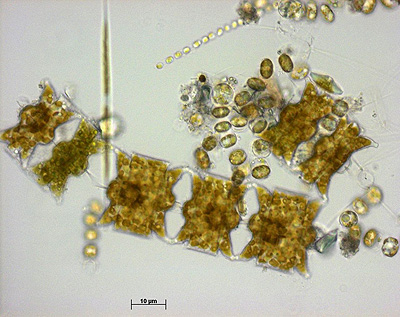 Phytoplankton showing a variety of algal species,
Phytoplankton showing a variety of algal species,taken from Long Island Sound during the
winter bloom
Algae
- Very varied in size from microscopic single cells to giant kelp 65m long.
- Simple plants without true stems, leaves or roots.
- Live in aquatic habitats or moist conditions such as on damp rocks, soil or wood.
The algae are not a natural group in that they are more or less what is left after the easier to recognize groups are taken out. They are therefore incredibly varied in habit, habitat, size and appearance from microscopic to what you would recognize as normal plant size. They are most commonly seen as sea weeds and also wherever there is a green film of growth on anything. They make up nearly all of the phytoplankton in the worlds seas, oceans, lakes and other bodies of water and between them are responsible for about half of all the oxygen produced by photosynthesis on earth.
Algae examples - pond weed is algae of different forms, wherever you live in the world a green growth will form on the surface of ponds, while this will be different in different places, it will almost undoubtedly be algae, especially if it's that yucky stringy stuff. Also, sea weed, kelp, bladder-wrack, diatoms (phytoplankton), snow algae. Algae is often green but can be almost any shade of brown, red, yellow, though it is more commonly drab rather than bright (apart from the many bright greens).
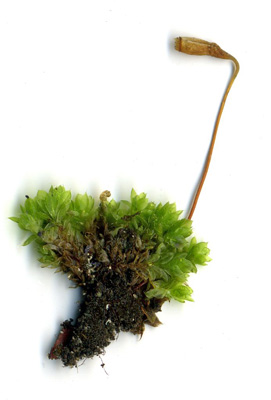 Moss with an empty sporangium,
Moss with an empty sporangium,the fruiting body that produces
spores (like seeds but smaller)
Bryophytes Mosses and Liverworts
- Non vascular plants, no tissues that carry water or other substances around the plant.
- Simple roots.
- Reproduce by making spores rather than seeds.
- Many species produce swimming sperm.
Liverworts are not so common plants that live in damp places, to see them you have to know what you're looking for and where to look, they tend to be just a centimeter or two high, though they creep as they grow and reproduce and can cover large areas.
Mosses on the other hand are a lot more common and visible (if you live in a temperate climate zone, they may be growing on the roof of your house like they do on mine). Mosses also like to live in damp conditions, though can withstand some drying out. What they are often best at is growing in difficult places where other plants struggle, they aren't very good at competing in good conditions. You will find mosses in the undergrowth of woods almost everywhere in the world. They are also responsible for the formation of peat in peat bogs and are commonly found in wetlands, bogs, marshes, moors and anywhere that it is wet and/or shady, they might also be growing in your lawn if you have one.
Bryophyte examples - All mosses such as sphagnum moss which has a neat trick of exchanging a hydrogen ion for other ions it takes up (such as potassium and calcium) so making the place where it grows more acidic, other plants often find conditions very difficult, but sphagnum moss loves it like that. Not Spanish Moss, that's a flowering plant.
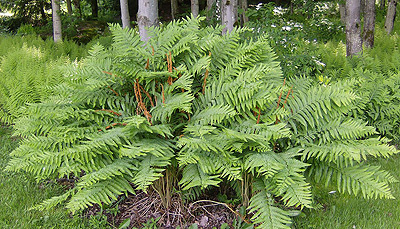 Cinnamon fern on the edge of woodland
Cinnamon fern on the edge of woodland
Pteridophytes Ferns, Clubmosses, Horsetails
- Vascular plants with large stems and roots.
- Reproduce by making spores rather than seeds.
- Have an alternation of generations with one producing the other, one is often much smaller, sexual reproduction.
- Many species produce swimming sperm.
The modern Pteridophytes are what is left of a once mighty dynasty. In the Carboniferous period from 360-300 million years ago, it was mainly giant Pteridophytes that were growing in great number and then dying and falling over in swamps to become buried and form what became the coal reserves of the world. These weren't the small plants that we have today that tend to live in out of the way places, but mighty tree-like versions 20-30m tall with trunks of 1-1.5m in diameter that ruled the plant world like no others. As time went on, they were largely replaced by flowering plants that were able to adapt better and faster to changing conditions until they were no longer the dominant forms of trees and large plants of the planet.
There are still some tree ferns that grow to 30m tall, though they are geographically isolated and not at all a representative of the group. Most members of the group are ferns with often finely divided leaves that are frequently used as decorative garden and house plants. They tend to frequent damp places but don't generally grow in water, they can often grow with relatively little light beneath trees, on walls or inside gullies where no direct sunlight ever reaches.
Pteridophyte examples - bracken, tree fern, ground pine, most of the species aren't very well known and often have descriptive names: alpine clubmoss, silver fern, great horsetail etc.

